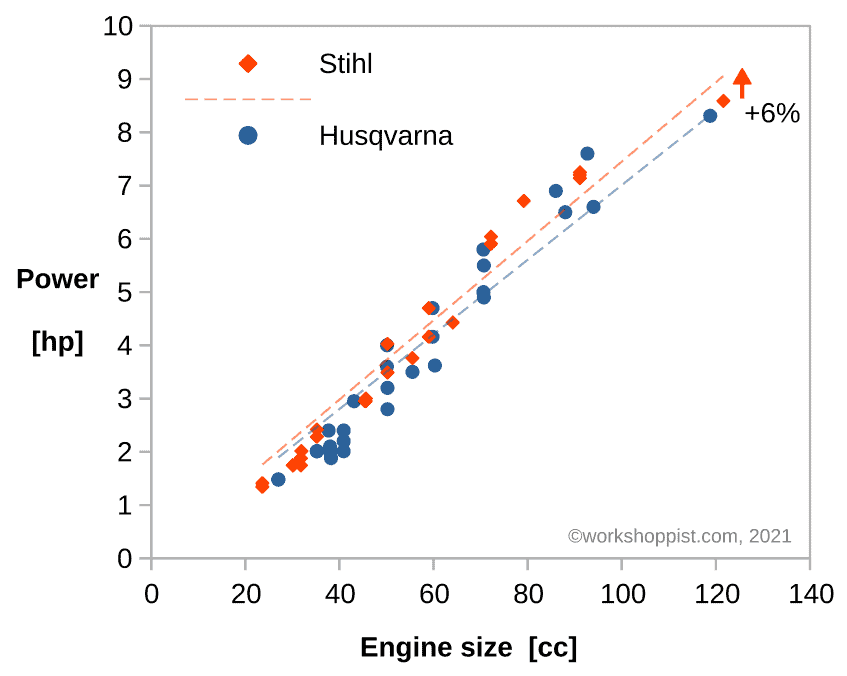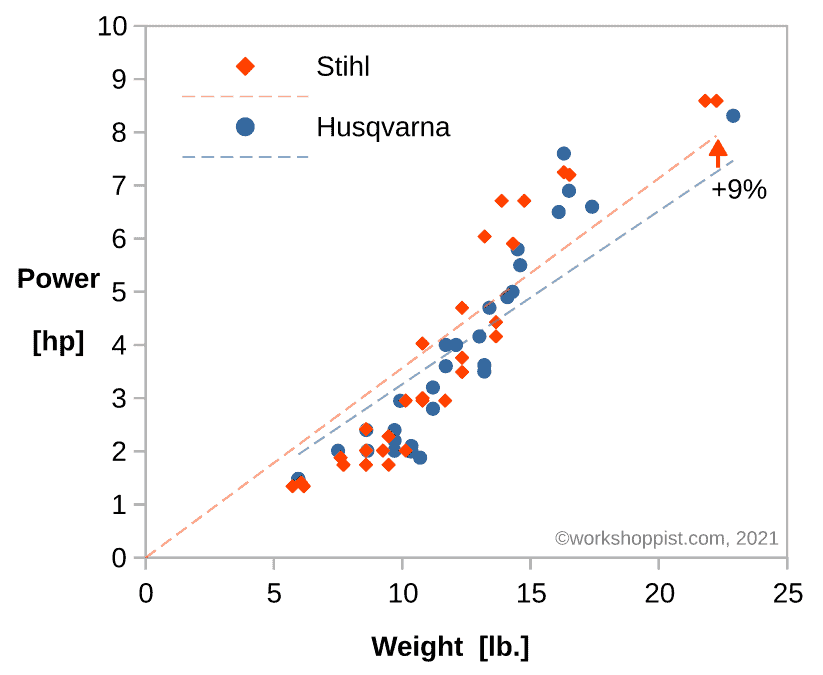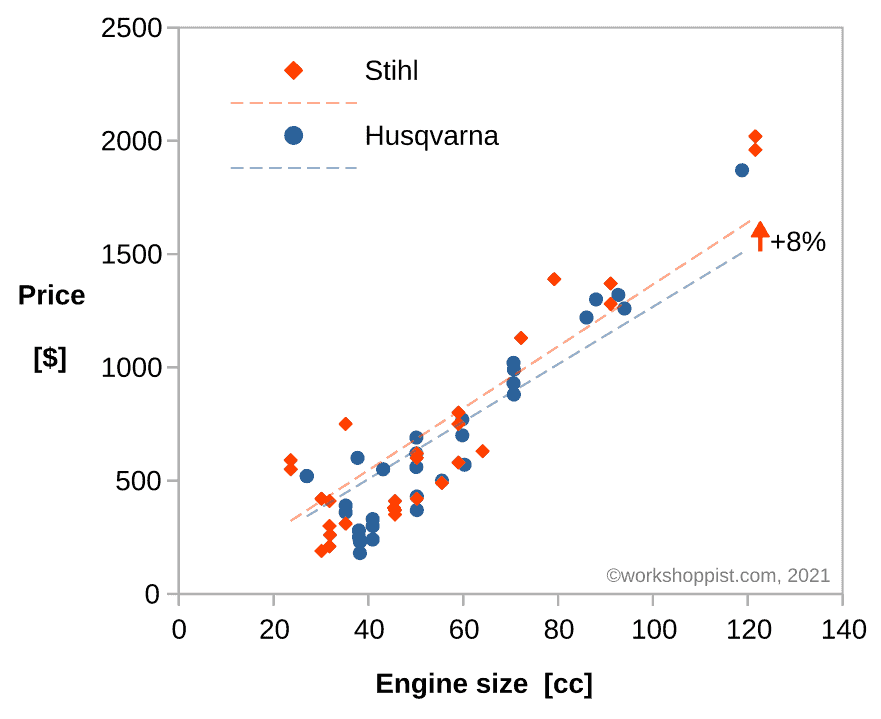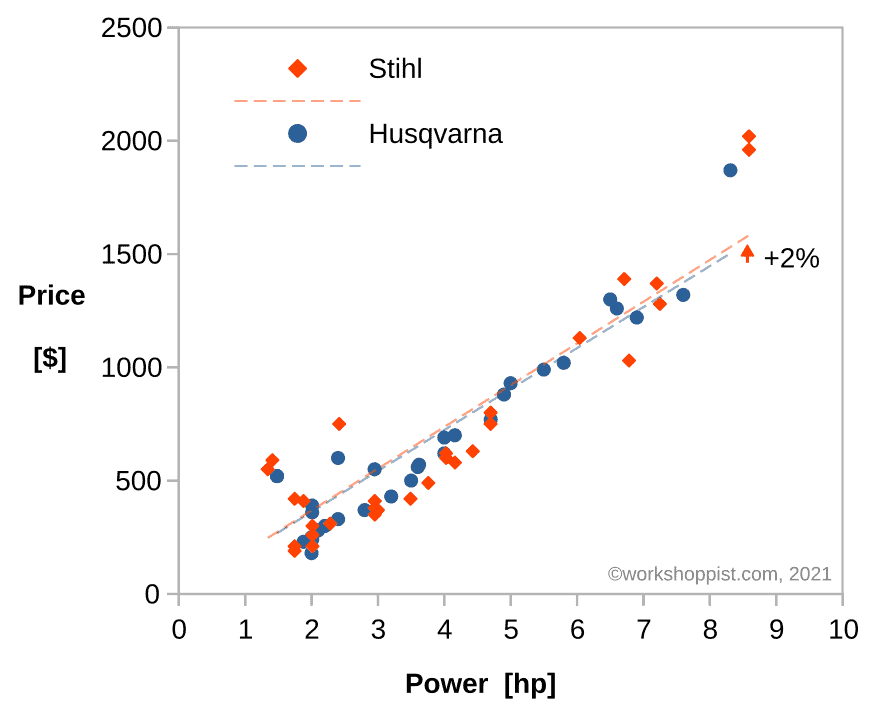The received wisdom holds that Stihl makes more powerful and cheaper chainsaws than Husqvarna, and that Stihl saws are more consumer-oriented and Huskies more professional. Always preferring hard numbers, I decided to do a bit of research on this, and found that these are not really true.
In this article, we’ll take a look at how Husqvarna and Stihl chainsaws really compare in performance numbers. The summary: Stihl chainsaws in 2021 have 6% more power per cc and 9% more power per pound, but Husqvarnas are 8% cheaper per cc and 2% cheaper per horsepower. Overall, the average performance difference between Husqvarna and Stihl chainsaws is negligible, and real performance differences are between the product lines within either brand.
Next, I will show these to you in four graphs which plot the Stihl and Husqvarna chainsaw lineups in the key performance specs available: power/cc, power/weight, price vs. cc and power vs. cc. You’ll see for yourself that Huskies are not really more expensive, and any power edge Stihl has is rather small.
Power/CC: Stihl wins

The ratio of output power to engine displacement – or hp per cc – is a basic performance metric for chainsaws. Saws with high hp/cc are usually modern highly-tuned professional saws.
The graph above plots the output horsepowers against saw weight (powerhead only) for Stihl and Husqvarna chainsaws available for purchase as new in August 2021.
The graph shows that Stihl (orange dot) and Husqvarna (blue dot) saws have on average very similar power vs. displacement ratios: the two point clouds show rising hp with cc (as expected) and noticeable scatter between models, but visually overlap.
The dashed lines show the calculated average hp/cc for each brand saws. These lines reveal that Stihl does have a slight 6% advantage in hp/cc average.
In my opinion, this difference in averages is too small to mean anything – variation between models is far more significant.
Power/Weight Ratio: Stihl wins

Power-to-weight ratio is one of the key specs the chainsaw manufacturers are competing with: we all want a powerful but lightweight saw.
The graph above shows the 2021 Stihl (orange) and Husqvarna (blue) chainsaw models plotted horsepowers versus weight in pounds.
Again, we see a rising trend, scatter, but mostly overlapping point clouds – Stihl and Husqvarna chainsaws have power-to-weight ratios in the same range.
The dashed lines mark the calculated average power-to-weight ratio for both brands. These show that Stihl chainsaws do in fact have 9% more power per pound than Husqvarna.
But this is only the brand averages – the model differences are again the main story of the graph. In fact, Husqvarna is narrowly beating Stihl in hp-per-lb with the excellent 35cc, 2.0hp top-handle T435 and the new 90cc saw 592 XP.
Another lesson from the graph: Small saws have much worse power-to-weight ratios than large ones – small saws are all below the average lines and large ones above.
Price vs. CC: Husqvarna wins

A big engine is all good, but at which price? For most of us, dollars per cc is perhaps the biggest concern when choosing a new saw.
The graph above plots the retail prices of Husqvarna (blue) and Stihl (orange) chainsaws against engine displacement. Husqvarna prices are US dollar, MSRP; Stihl gives no MSRP, so the prices are what I found online at various retailers. (The new Husq. 585 and 592 XP are included at their expected prices.)
This graph shows a similar story as the power graphs: two scattered rising point clouds that visually overlap. The conclusion: there is no major difference in Stihl and Husqvarna 2021 chainsaw prices when engine size is accounted for.
This is a surprising result, as we’ve all probably heard that Husqvarna saws would be more expensive than Stihls. The calculated averages (dashed lines) in fact indicate the opposite: relative to engine size Stihl chainsaws are on average 8% more expensive than Husqvarna saws!
However, in my opinion this average difference is too small to mean much. Once again the story is: small difference between brands, big differences between models.
(The 30…40cc saws are all over the place: you get the Husq. 240, 38cc, at $180, but pay $520 for the 27cc T525 – not to mention the 35cc MS201, yours for $750!)
Price vs. Power: It’s a tie

For most users, the number one “bang-for-the-buck” metric for chainsaws is not the above $/cc, but $/hp – that is dollars per horsepower.
The graph above plots the retail price against output horsepower for Husqvarna (blue) and Stihl (orange) chainsaws, again using the 2021 price data.
We see the dots of the two brands very well aligned on the graph, now also with very little scatter. Even dashed average lines overlap, showing Stihl a mere 2% more expensive than Husqvarna.
Conclusion: Relative to output horsepower, Husqvarna and Stihl chainsaws cost on average exactly the same. This runs counter to the popular belief that Huskies are expensive, so let me repeat:
For the horsepower, the average Husqvarna and Stihl chainsaw cost just the same.
Another point of interest in the chart is the reduced scatter compared to the price-per-cc plot: once we account for the higher tuning and horsepower of the expensive pro-series saws, most models actually fall in line. Relative to output power, the pricing is fair after all.
There are two exceptions, though: climbing arborists pay a size&weight premium for their 1.5…2.5hp top-handles, while heavy-duty loggers pay extra for the 120cc flagship models.
Conclusion
My takeaway from the four charts: Stihl and Husqvarna are basically even on all of the key specs. The biggest difference was in average power-to-weight ratio, and even that was below 10%.
This result was a bit surprising to me, given all the talk about Huskies being more expensive, Stihls more powerful, and so on. Stihls had a little more power per cc and lb on average, but Husqvarna was actually cheaper per cc; per hp the price was the same. Further, any difference in the averages was small and pretty meaningless.
The real differences were within brands: pro and consumer saw models had very different power-to-weight ratios, not to mention the prices.
But for output power, most Stihls and Husqvarna saws were actually fairly priced – except for arborists and heavy loggers.